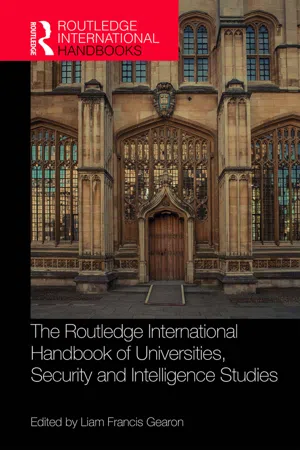
The Routledge International Handbook of Universities, Security and Intelligence Studies
- 546 pages
- English
- ePUB (mobile friendly)
- Available on iOS & Android
The Routledge International Handbook of Universities, Security and Intelligence Studies
About This Book
In an era of intensified international terror, universities have been increasingly drawn into an arena of locating, monitoring and preventing such threats, forcing them into often covert relationships with the security and intelligence agencies. With case studies from across the world, the Routledge International Handbook of Universities, Security and Intelligence Studies provides a comparative, in-depth analysis of the historical and contemporary relationships between global universities, national security and intelligence agencies.
Written by leading international experts and from multidisciplinary perspectives, the Routledge International Handbook of Universities, Security and Intelligence Studies provides theoretical, methodological and empirical definition to academic, scholarly and research enquiry at the interface of higher education, security and intelligence studies.
Divided into eight sections, the Handbook explores themes such as:
-
- the intellectual frame for our understanding of the university-security-intelligence network;
-
- historical, contemporary and future-looking interactions from across the globe;
-
- accounts of individuals who represent the broader landscape between universities and the security and intelligence agencies;
-
- the reciprocal interplay of personnel from universities to the security and intelligence agencies and vice versa;
-
- the practical goals of scholarship, research and teaching of security and intelligence both from within universities and the agencies themselves;
-
- terrorism research as an important dimension of security and intelligence within and beyond universities;
-
- the implication of security and intelligence in diplomacy, journalism and as an element of public policy;
-
- the extent to which security and intelligence practice, research and study far exceeds the traditional remit of commonly held notions of security and intelligence.
Bringing together a unique blend of leading academic and practitioner authorities on security and intelligence, the Routledge International Handbook of Universities, Security and Intelligence Studies is an essential and authoritative guide for researchers and policymakers looking to understand the relationship between universities, the security services and the intelligence community.
Frequently asked questions
Information
PART I
Universities, security and intelligence studies
An academic cartography
1
The university-security-intelligence nexus
Four domains
Introduction
set up my staff at the library door in Oxon; being thoroughly persuaded, that in my solitude, and surcease from the Commonwealth affairs, I could not busy myself to better purpose, than by reducing that place (which then in every part lay ruined and waste) to the public use of students. (Bodley, 2006)
In 1610 Bodley entered into an agreement with the Stationers’ Company of London under which a copy of every book published in England and registered at Stationers’ Hall would be deposited in the new library. Although at first the agreement was honoured more in the breach than in the observance, it nevertheless pointed to the future of the library as a comprehensive and ever-expanding collection, different in both size and purpose from the libraries of the colleges. (Bodleian, 2019)
Unable to target or repel terrorists using conventional military tactics and munitions alone, the United States is acutely aware that today’s pivotal battlefield is an informational one. Teams of U.S. intelligence agents, acting as eavesdroppers, infiltrators, interrogators, and data-miners, must race against the clock to anticipate terrorists’ actions, frustrate their missions, and dismantle their infrastructure. Because the U.S. government does not know the who, what, where, and when of the next terrorist strike, but recognizes that might be hatched on domestic soil, its first step must be to cast a gather all sorts of data points, any one of which might be the clue intelligence agents to prevent another September 11-like catastrophe. In this regard, there is no better ally than the private sector. Its comparative over the government in acquiring vast amounts of potentially useful function both of industry’s unparalleled access to the American intimate affairs-access given by all those who rely on businesses their personal, social, and economic transactions-and of asymmetries insofar as private organizations can at times obtain information more easily and under fewer legal restrictions than the government can when it collects similar information. (Michaels, 2008: 901–902)
…the NSA hired Edward J. Snowden to help with some of its computer work. At the time of his hiring in 2013, Snowden – a 29-year-old high school dropout from suburban Maryland and a former CIA computer specialist – was under contract as a data specialist with the giant defence firm Booz Allen Hamilton. In his short stint with the NSA, Snowden reportedly stole some 1.7 million classified documents from the agency’s computers. He leaked many of these documents over the next year to American and British journalists, as a protest against what he viewed as improper surveillance methods used by the NSA against American and British citizens. (Johnson et al. 2014: 14)
Fundamentally, privacy is being abolished – not eroded, not diminished, not encroached upon, but abolished. And being constructed in its place is a colossal digital new Stasi, driven by a creepy intoxication with what is now technically possible, combined with politicians’ age-old infatuation with bullying, snooping and creating mountains of bureaucratic prestige for themselves at the expense of the snooped-upon taxpayer. (Bradshaw, 2014)
Table of contents
- Cover
- Half Title
- Series Page
- Title Page
- Copyright Page
- Table of Contents
- Contributors
- Introduction
- PART I Universities, security and intelligence studies: an academic cartography
- PART II Universities, security, intelligence: national contexts, international settings
- PART III Espionage and the academy: spy stories
- PART IV Spies, scholars and the study of intelligence
- PART V University security and intelligence studies: research and scholarship, teaching and ethics
- PART VI Security, intelligence, and securitisation theory: comparative and international terrorism research
- PART VII Universities, security and secret intelligence: diplomatic, journalistic and policy perspectives
- PART VIII Universities, security and intelligence: disciplinary lenses of the arts, literature and humanities
- Index